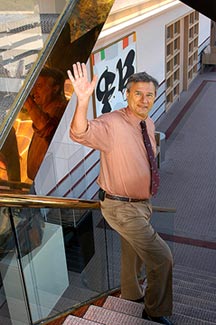Iowa Eye Association News
Oct. 2004. Series 2, no. 39.
Iowa Eye Association News Oct. 2004. Series 2, no. 39. |
 Update
UpdateThere
is a difference between “stepping down” and retiring.
I... am... not... retiring....
If
you check the dictionary, you’ll see that “retired,” means “having
stopped working, typically after working many years.” Well, there’s
some truth to be found there, isn’t there? Most days it feels as though
I have worked many years. However, I see many more years to come.
As many of you know, I have devoted some time to the study of choroidal melanomas. Ophthalmologists and vision scientists understand the eye’s crucial role as a model of human disease and discovery. The eye and visual system have served as models in physiology, pharmacology, neuroscience, immunology, molecular biology, and pathology, among others. Thus, I am thrilled that after a new Head of the Department comes aboard, I will join Mary Hendrix, Ph.D., who was formerly at Iowa, and her research team. Dr. Hendrix is now President and Scientific Director of Children’s Memorial Hospital Research Center. I believe the findings from her lab have far ranging implications regarding cancer.
During this research period, I will commute on my new, private Lear jet between Iowa City and Chicago. My work at the CMH at Northwestern should energize and educate me, as well as enhance my research skills for the study of uveal melanoma.
The plan is to then to return full-time to the Department, where I will continue with my research, see patients in the Vitreoretinal Service, and teach. During 2003, I had the luxury of seeing more referral patients and I feel re-invigorated: Solving complex clinical problems and teaching at all levels remains a thrill. This is why I love ophthalmology. I am confident that my planned “sabbatical” is merely the next step in a career that has been extremely gratifying.
In the meantime, I will continue to help maintain the best ophthalmology program possible. We will continue to recruit research-scientists and clinicians, and look to expand our clinical and research facilities. Like many medical institutions, we face financial demands and the tension of maintaining the resources crucial to excellence. Fortunately, our superb faculty is extremely supportive and loyal. Even though many have been offered positions elsewhere with more money, endowed positions, and attractive recruitment packages, they refuse to leave Iowa. They are loyal to the Department. I will always see it as my job, and the future Head’s, to provide the best environment and resources. We will work hard to always be among the greatest ophthalmology programs in the world. You know our motto: “Together we have a vision for the future.”
And by the way, I don’t have a Lear jet. That was a joke. This isn’t: My door’s open. Come talk with me if you have any questions or concerns.
Tom Weingeist
I would like to ask a favor of you. Please consider supporting Research to Prevent Blindness by becoming an Associate Member or making an outright gift. RPB has been a tremendous asset to the Department of Ophthalmology and Visual Sciences which, to date, has received more than $2.5 million in support.
RPB is the largest philanthropic organization supporting research in academic departments of ophthalmology. Without their support the Center for Macular Degeneration, the Oakdale Research Facility, and the Blodi Ocular Pathology Laboratory would not exist. They provided the seeds and nurtured the saplings that built these structures and helped support the faculty in these institutions. Your support can make a difference.
For more information see their web site.
|
(requires Adobe Acrobat Reader) |
|||
| "Together,
we have a vision for the future." |
Copyright © University
of Iowa, 2004 |
||